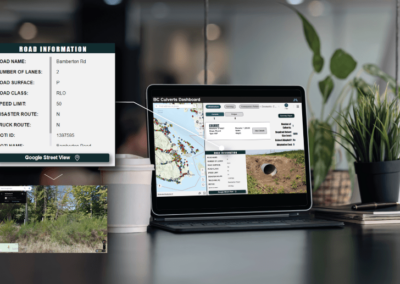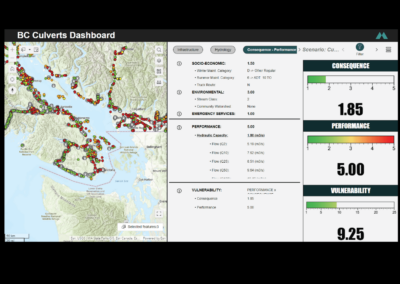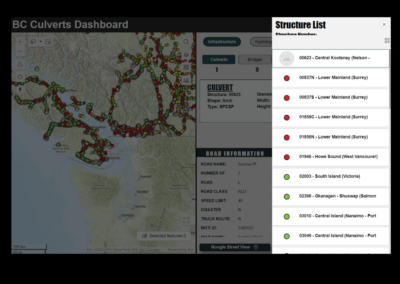About the Project
The rain and flooding that struck southwestern BC in November 2021 broke dozens of all-time rainfall records, with some communities seeing nearly a month’s worth of rain. The floods and landslides were devastating and deadly, claiming the lives of five people and hundreds of thousands of livestock. The conditions cut off all road and rail routes between Metro Vancouver and the rest of Canada, leaving many communities – specifically First Nations groups – completely cut off.
Climate change has made it much more likely that this type of disaster will happen again. The lesson learned from this event is existing infrastructure required to convey water from extreme events is aging. Many culverts are not able to convey flows from these storms and will not be able to handle more extreme events that are predicted to come in the future, as they are now exposed to greater climate hazards than they were initially designed to withstand.
The BC Ministry of Transportation and Infrastructure (MoTI) is responsible for over 15,000 culverts in the province. MoTI needed to understand which of these culverts are most vulnerable and which would have the highest impact on surrounding communities if they failed. The purpose of this project was to develop a methodology to proactively identify, rank, prioritize, and map culverts at high-risk to climate change and extreme weather for future adaptation, such as upgrading or replacement.
McElhanney developed a workplan that included examining systems for collecting, developing, and analyzing information and using multiple criteria decision analysis in ranking and prioritizing culverts vulnerability to climate change. The result is the Culvert Vulnerability Asset Management System (CVAMS).
While the concept of asset management is not new, what was innovative about this project was that it combined multiple processes into one user-friendly platform.
Approach
The core concept of the analysis was identifying where mapped watercourses intersect a MoTI road. With crossings identified, upstream watersheds were delineated, and physiographic attributes determined.
We then completed hydrologic analysis to estimate the flow for various return periods and hydraulic capacity, assessing the amount of water a culvert (or group of culverts) can safely convey. The performance rating of a crossing compares the available conveyance to the estimated flow. Performance ratings and subsequent vulnerability ratings are attached to a climate scenario (current climate, climate change, or incremental increase).
The consequence rating, comprised of the socio-economic, environmental, and emergency services ratings, are assigned to a crossing.
Throughout the project, McElhanney held workshops with MoTI staff to develop a plan to help identify priority projects to address culvert vulnerability. During the initial phase of the project, McElhanney reviewed all available datasets and completed a data gap assessment. The data gap assessment identified deficiencies in the available culvert information, as well as climatic datasets that we recommended collecting in the future to help in vulnerability assessment of each culvert.
The conclusion of the project was the development of a dashboard that presents the vulnerability assessment for a crossing, based on its performance under various climate scenarios and the consequences if the culvert fails.
Results
The value of the CVAMS is that it provides the right information to the right people. Solutions for responding to climate change vary based on assets and require detailed engineering analysis. What was previously missing was a means to identify the most vulnerable culverts in a quick and understandable manner. The CVAMS and resulting dashboard allows MoTI to determine the vulnerability to climate change of the many culverts in their inventory in an innovative yet simple manner.
Service(s) Provided
Data Collection and Management
Engineering Analysis (including hydrologic analysis, hydraulic analysis and climate change analysis)
Application Development
User Engagement
Go back to projects in
View other projects from
Stay in touch with us
Subscribe to our mailing list!
Organization
Connect






